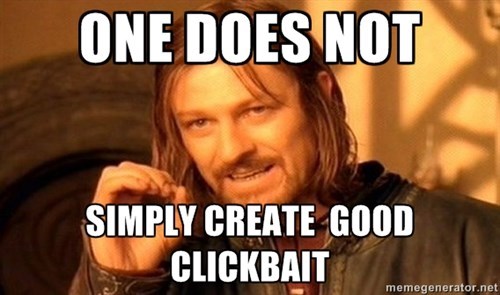Journalism, copywriting and the psychology of the clickbait headline
08 May 2014
Clickbait.
It's a dirty word isn't it? Sounds a bit like jailbait, and immediately has negative connotations.
If you've been hiding under a rock and not engaging with news or social media at all, clickbait is the way media outlets like Upworthy, Buzzfeed and Huffington Post have been creating content designed to draw people in with psychologically persuasive headlines. This is an example from Upworthy.
"These children say more about gun control in dance than Congress has in any law kinda ever http://t.co/J4FWhgZcju" — Upworthy (@Upworthy) May 1, 2014
Atlantic Senior Editor Adrienne LaFrance has a great article which outlines the process for creating these types of headlines in three steps.
1. Publish something that matters
2. Package it in a way that makes it really compelling, by creating a curiosity gap which makes a reader feel that they need to click on the link, leading to content good enough to match or exceed their expectations.
3. Tailor the content to every social platform and push it aggressively, writing different headlines depending on the audience.

This cartoon humorously shows how these headlines work, illustrating how famous events of the 20th century would work if the headlines were turned into clickbait.
Web journalists for a few years had to consider keywords and SEO as a top priority in their articles. But Google changed its search algorithm a number of times, meaning that other factors such as social have become important. And because social media like Facebook and Twitter can drive big numbers to an article, writers are now factoring in the viral potential of posts.
This is why clickbait style articles have become popular, because they work. It involves a fair bit of psychology - creating a state in the reader where they need to know what's contained in the article, but without giving away the whole story in the headline.
This is not easy thing to consider for a traditional journalist, who generally thinks more about publishing a great story rather than how many eyeballs it will get. But the reality for publishers is that more traffic = more advertising revenue = survival. Journalists have had to learn this fast.
A note on this though: People expect it from news brands like Buzzfeed, but not with more respected 'serious' publishers where there has already been push back. When the CNN tried a clickbait style headline on a particularly serious news story recently, it didn't go down at all well.
For marketing copywriters though, the art of the clickbait headline is something that they should feel comfortable with. After all, the traditional copywriter thinks about persuasion - getting the reader to buy a product or influencing their beliefs.
Some publishers run headlines through A/B testing, something which also should be familiar to marketers working with emails and testing out subject lines. With effective emails good copywriters have been playing around with subject lines to make them more personal to the reader, sometimes using the curiosity gap.
Subject lines like "We were really surprised how well this worked" or "Our existing customers have saved a fortune, we've got the secret". Simple examples, but you get the idea.
A warning though: one thing a copywriter should think about when looking at clickbait is the effect it will have on the brand you're representing. It's not good practice to 'trick' a reader into clicking on a link with disappointing content - that will not reflect well on the company concerned.
And if you think about journalism clickbait, unless it's a familiar news website, you don't really feel much connection with the publisher - if it's particularly bad website content you could even feel negatively towards it.
So with headlines there's no harm in taking ideas from the clickbaiters, but it's something to be very careful about if you want to represent your brand in the best light.

